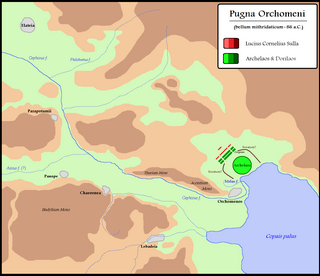Related Research Articles
80s BC is the time period from 89 BC – 80 BC.

Lucius Licinius Lucullus was a Roman general and statesman, closely connected with Lucius Cornelius Sulla. In culmination of over 20 years of almost continuous military and government service, he conquered the eastern kingdoms in the course of the Third Mithridatic War, exhibiting extraordinary generalship in diverse situations, most famously during the Siege of Cyzicus in 73–72 BC, and at the Battle of Tigranocerta in Armenian Arzanene in 69 BC. His command style received unusually favourable attention from ancient military experts, and his campaigns appear to have been studied as examples of skillful generalship.

The Mithridatic Wars were three conflicts fought by Rome against the Kingdom of Pontus and its allies between 88 – 63 BC. They are named after Mithridates VI, the King of Pontus during the course of the wars who initiated the hostilities after annexing the Roman province of Asia into its Pontic Empire and committing massacres against the Roman inhabitants there. Mithridates was able to organise revolts against advancing Roman troops and play off the political factions of the optimates and populares against one another in the Roman civil wars. Nevertheless, the first war ended with a Roman victory, confirmed by the Treaty of Dardanos signed by Sulla and Mithridates. Greece was restored to Roman rule and Pontus was expected to restore the status quo ante bellum in Asia Minor.

The First Mithridatic War was a war challenging the Roman Republic's expanding empire and rule over the Greek world. In this conflict, the Kingdom of Pontus and many Greek cities rebelling against Roman rule were led by Mithridates VI of Pontus against Rome and the allied Kingdom of Bithynia. The war lasted five years and ended in a Roman victory, which forced Mithridates to abandon all of his conquests and return to Pontus. The conflict with Mithridates VI later resumed in two further Mithridatic Wars.
Lucius Licinius Murena was a Roman soldier and politician. He was notable for playing an important role in the Roman victory against the forces of Mithridates VI of Pontus at the Battle of Chaeronea in 86 BC during the First Mithridatic War and for starting another war, the Second Mithridatic War, against Mithridates in Asia Minor without the authorisation of the Roman senate.

The Third Mithridatic War, the last and longest of the three Mithridatic Wars, was fought between Mithridates VI of Pontus and the Roman Republic. Both sides were joined by a great number of allies, dragging the entire east of the Mediterranean and large parts of Asia into the war. The conflict ended in defeat for Mithridates; it ended the Pontic Kingdom and the Seleucid Empire, and also resulted in the Kingdom of Armenia becoming an allied client state of Rome.

The Battle of Orchomenus was fought in 85 BC between Rome and the forces of Mithridates VI of Pontus. The Roman army was led by Lucius Cornelius Sulla, while Mithridates' army was led by Archelaus. The Roman force was victorious, and Archelaus later defected to Rome. The battle ended the Mithridatic invasion of Europe. Information on the battle is included in Plutarch's Life of Sulla, chapters 20–21.

The Battle of Artaxata was fought near the Arsanias River in 68 BC between an army of the Roman Republic and the army of the Kingdom of Armenia. The Romans were led by proconsul Lucius Licinius Lucullus, while the Armenians were led by Tigranes II of Armenia, who was sheltering Mithridates VI of Pontus. The battle was part of the Third Mithridatic War, and was a Roman victory.

The siege of Cyzicus took place in 73 BC between the armies of Mithridates VI of Pontus and the Roman-allied citizens of Cyzicus in Mysia and Roman Republican forces under Lucius Licinius Lucullus. It was in fact a siege and a counter-siege. It ended in a decisive Roman victory.
The Battle of Cabira was fought in 72 or 71 BC between forces of the Roman Republic under proconsul Lucius Licinius Lucullus and those of the Kingdom of Pontus under Mithridates the Great. It was a decisive Roman victory.
The Battle of Lemnos was fought on the island of Lemnos in 73 BC between a Roman fleet and a Mithridatic fleet; it was a decisive event during the Third Mithridatic War. The primary chroniclers of the battle are Appian, Cicero and Memnon, but there remain debates about the specifics in these different accounts.

The lex Manilia was a Roman law passed in 66 BC granting Pompey the military command in the East against Mithridates VI of Pontus.

Pontus was a Hellenistic kingdom centered in the historical region of Pontus in modern-day Turkey, and ruled by the Mithridatic dynasty of Persian origin, which possibly may have been directly related to Darius the Great of the Achaemenid dynasty. The kingdom was proclaimed by Mithridates I in 281 BC and lasted until its conquest by the Roman Republic in 63 BC. The Kingdom of Pontus reached its largest extent under Mithridates VI the Great, who conquered Colchis, Cappadocia, Bithynia, the Greek colonies of the Tauric Chersonesos, and for a brief time the Roman province of Asia. After a long struggle with Rome in the Mithridatic Wars, Pontus was defeated.
Marcus Marius was a quaestor of the Roman Republic in 76 BC and proquaestor under Quintus Sertorius's government in exile in Spain. Marius was sent by Sertorius to Mithradates of Pontus as an advisor and military commander in the Third Mithridatic War. He is named as or more likely confused with a Varius in Appian.
The Battle of Zela, not to be confused with the more famous battle in 47 BC, was fought in 67 BC near Zela in the Kingdom of Pontus. The battle resulted in a stunning Pontic victory and King Mithridates' successful reclamation of his kingdom. Mithridates' victory was short-lived however, as within a few years he would be completely defeated by Pompey the Great.

The Battle of Chalcedon was a land and naval battle between the Roman Republic and King Mithridates VI of Pontus near the city of Chalcedon in 74 BC. It was the first major clash of the Third Mithridatic War. The Roman forces were led by Marcus Aurelius Cotta, one of the consuls for 74 BC, while Mithridates had the overall command of the Pontic forces. The Mithridatic forces were victorious on both land and sea.
The Battle of the Rhyndacus occurred in 73 BC between a Roman Republican force under the command of the proconsul Lucius Licinius Lucullus and a division of the army of Mithridates VI of Pontus as part of the Third Mithridatic War. The Romans were victorious.

Quintus Bruttius Sura was a Roman commander who fought in the First Mithridatic War. He was the first Roman commander to successfully resist Mithridates' advance.
The siege of Heraclea was a military investment of the city of Heraclea Pontica during the Third Mithridatic War. The siege was conducted by the Roman proconsul Marcus Aurelius Cotta and the legate Gaius Valerius Triarius. They were besieging the adherents of Mithridates of Pontus, who held the city for the Pontic king. Heraclea was located on the strategically important northern land route into the kingdom of Pontus and had been taken and garrisoned by Mithridates on his retreat from the Siege of Cyzicus. The 4,000-man strong Mithridatic garrisoned was commanded by Connacorex, one of the king's generals, and held out for almost two years. After taking Heraclea, the Romans plundered the city extensively.
Gaius Valerius Triarius was a First Century BC Roman politician and general, a member of the gens Valeria. During the Third Mithridatic War he served as a legate to Lucius Licinius Lucullus, the Roman commander in charge of the war effort against king Mithridates VI of Pontus. He played a pivotal role in the capture of Heraclea Pontica, but was later defeated by Mithridates at the Battle of Zela in 67 BC.
References
- ↑ Brennan, The Praetorship in the Roman Republic, p. 526.
- ↑ Philip Matyszak, Mithridates the Great, Rome's Indomitable Enemy, pp 81-82.
- ↑ Philip Matyszak, Mithridates the Great, pp 85-86.
- ↑ Philip Matyszak, Mithridates the Great, pp 89-90.
- ↑ Philip Matyszak, Mithridates the Great, pp 93-96.
- ↑ Lee Fratatuono, Lucullus, pp 36-37; Plutarch, Life of Lucullus, IV.2-3.
- ↑ Lee Fratatuono, Lucullus, pp 38-39; Seutonius, Divus Iulius, II
- ↑ Lee Fratantuono, Lucullus, the life and campaigns of a Roman conqueror, p.51 and p.55; Sallust, Historiae III, fr.16.
- ↑ Lee Fratantuono, Lucullus, pp 57-61; Philip Matyszak, Mithridates the Great, pp 106-113.
- ↑ Philip Matyszak, Mithridates the Great, p.118.
- ↑ Philip Matyszak, Mithridates the Great, p.139.
- ↑ Philip Matyszak, Mithridates the Great, p.140.
- ↑ Plutarch, Life of Lucullus, 35.
- ↑ Lee Fratantuono, Lucullus, p.112.
- ↑ John Leach, Pompey the Great, p.76.
- ↑ John Leach, Pompey the Great, pp 79-80; Philip Matyszak, Mithridates the Great, pp 150-151.
- ↑ John Leach, Pompey the Great, p.82.